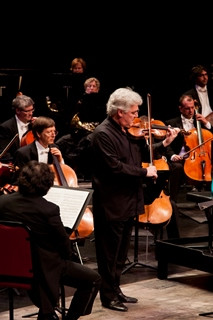|
Back
Major Challenges and High Expectations Ottawa
Southam Hall, National Arts Centre
09/26/2014 -
Wolfgang Amadeus Mozart: Violin Concerto No. 5 in A major, K. 219
Ludwig van Beethoven: Overture to Egmont, Op. 84 – Symphony No. 7 in A major, Op. 92
National Arts Centre Orchestra, Pinchas Zukerman (conductor and violin)

(© Shin Sugino)
It was a warm, late September evening in Ottawa and a sold out Southam Hall greeted Pinchas Zukerman for the opening night of his final season as music director for the National Arts Centre Orchestra. The first in a series billed ‘Vienna Festival’, celebrating repertoire by the most legendary composers from that city, it was a program of major challenges and high expectations. If the first half was often tentative, Zukerman and his players delivered their best work in a detailed, vigorously focussed and sustained reading of Beethoven’s Symphony No. 7 which left the entire audience knowing it was hearing one of the composer’s most immaculately realized masterpieces.
This was even more surprising, given the academic, rather routine playing of Beethoven’s Overture to Egmont, which initiated the concert. The first half continued with Mozart’s Violin Concerto No. 5. Zukerman conducted and was violin soloist in a performance both interesting and imaginative but which didn’t quite work. With barely thirty players on stage, the orchestra had been trimmed down to chamber size and Zukerman worked hard to match the ensemble’s texture and more understated dynamic range. The results nonetheless were mixed. Too often, sonorities from both orchestra and soloist were more thin than delicate, and this is one concerto where being soloist and conductor may not be a good idea. The performance likely would have worked better with a separate conductor to balance orchestra and soloist, and allow the soloist to focus on performing and not worrying about such issues.
Zukerman, to be sure, had some admirable moments, especially in the first movement cadenza which was fluidly, almost luxuriously poised. Intonation, though, began to waiver by the final movement (ditto for a brass player). And even with the scaled down forces, the orchestra played mainly at the same, rather square dynamic level it had managed for the earlier Overture to Egmont, though the balletic ‘Turkish’ section came off with humour and affection.
After intermission, it became clear that Zukerman and his players had placed their most concentrated effort on the Beethoven Symphony. From the broad opening chords before major themes take off, this was a reading of indisputable continuity, substance and authority. Tempi were brisk, even during the Allegretto second movement, but the approach was consistently smooth and invigorating and, as in the Mozart Concerto, the dance derived sections were particularly beautifully realized. Zukerman knew what he wanted, and his players understood him totally, so listeners could relax and relish such a fine experience. The result was a brilliant performance that bodes well for the National Arts Centre Orchestra’s continuing season.
Charles Pope Jr.
|